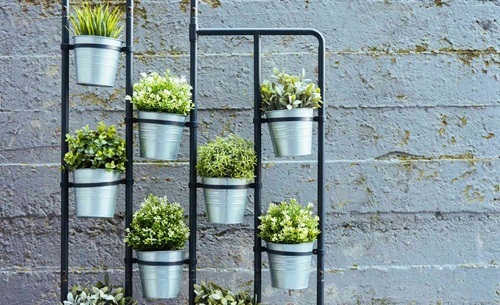Jun 4th 2025
Vertical Gardens: A Beginner’s Guide to Growing Upward
To transform your area from mediocre to spectacular, a clever and imaginative vertical garden might be exactly what you need. Plants that are raised, towered up, encouraged to climb, or staggered vertically are known as vertical plantings.
In addition to creating a lovely place, gardening will strengthen your bond with the natural world and increase your awareness of available resources and how to use them.
So, if you want to plant but have limited space, what should you do? Don't worry if your yard isn't large enough for a typical garden; vertical gardening is a fantastic choice, and that's precisely what we'll discuss in this article.
What is a Vertical Garden?
A vertical garden is one that is planted in a hanging structure or in layers that are stacked vertically. Because it doesn't need a lot of space, this type of garden is ideal for smaller areas. This means using a tall structure to support containers or growing your plants on trellises or fences. It might be a pair of shelves with pots attached to them or a six-foot trellis in the middle of a garden bed.

It might be hooks, stakes, or baskets hanging from a patio roof. Perhaps it's a living wall. Plus, there are many intriguing designs available if you don't want to put together your own system. There are also designs like hydroponic towers, which are easy to manage and can grow without soil.
How to Build a Vertical Garden
Addressing the "how" is the next stage in any important guide. Here, we’ll go over some key points that will be useful to people who are new to the concept of vertical gardening.
Choose the Right Location
The success of your vertical garden depends on the area you choose. Choose a location that gets enough sunshine throughout the day; for plants that need full sun, south-facing areas frequently offer the optimum exposure. Also, make sure the location is shielded from severe gusts, since they might dry your plants or harm your vertical garden. Keep in mind that plants require the ideal ratio of light to shade in order to frow fully.
Decide What Plants to Grow
Select plants that will flourish in your surroundings based on the lighting conditions at your location. If you're new to gardening, start with low-maintenance plants like herbs or succulents.
When starting a vertical gardening project, carefully think about the design and kinds of plants that will become your green oasis. To guarantee that your vertical garden flourishes and improves your living area, think about the right aesthetics and layout.
Keep in mind that vegetables typically require 6 to 8 hours of direct sunshine, regardless of how they are cultivated. Choosing a surface that faces the midday sun or west to capture the afternoon light can help you maximize the amount of sunshine in most regions.
Pole beans, climbing peas, sweet potatoes, vining tomatoes, and spreading varieties of squash, cucumber, melon, and zucchini can be taught to grow upward and are some great veggies to grow vertically.
Choose a Structure
Selecting a structure that is too large or that cannot be modified or added to is the first blunder you could make. You should consider if you want the structure to be permanent or if you want to be able to take it with you if you are renting, or relocate it to more sunny locations during the year. Use lightweight, portable materials if you are constructing a vertical structure specifically for the purpose of designing your garden.
- Wall-mounted vertical garden: In this type of vertical garden, the plants are held in place by hanging planters or shelves that are fixed straight to the wall.
- Floor-to-ceiling vertical garden: This kind of vertical garden is ideal for vast areas since it stretches from the floor to the ceiling.
- Hanging vertical garden: This vertical garden is ideal for compact areas and may be hung from the ceiling or a stand.
- Vertical Towers: Garden towers are a fantastic choice if you're searching for a simple vertical garden that can be used both indoors and outdoors.
- Window-box vertical garden: You can grow plants on your windowsill with this kind of garden, which is fixed to the window frame.
Installation and Maintenance
A vertical garden can be installed as a small-scale do-it-yourself effort or as a major professional undertaking. There are important things to think about when it comes to installation and upkeep:

Installation: For wall-mounted planters and modular systems, be sure to follow the manufacturer's instructions. If you're doubtful about your talents or the job is large-scale, don’t be afraid to get expert help.
Watering: The plants in your vertical garden will demand different amounts of water. By installing irrigation systems like drip lines or hand watering, you can guarantee constant moisture levels while taking into account each plant's unique drainage requirements.
Fertilization: In order to make up for their limited root systems, vertical gardens usually need regular fertilization. Regularly apply a water-soluble fertilizer to provide your plants the nutrition they need.
Pest control: Pay close attention to your plants for any indications of infestation, since vertical gardens are not immune to pests. Use environmentally friendly pest management techniques to keep pests away from your plants and maintain their health.
How to Care for a Vertical Garden
Row tilling and weeding are not necessary for vertical gardens. They do, however, require water. Although rainfall will provide some irrigation for outdoor vertical gardens, they will require water during dry spells. To allow extra water to drain, be sure that any containers you use have enough drain holes. To give the plants nourishment, you can use a fertilizer that dissolves in water. Your eco-friendly vertical garden will be a colorful addition to your house with a little bit of preparation and attention.




